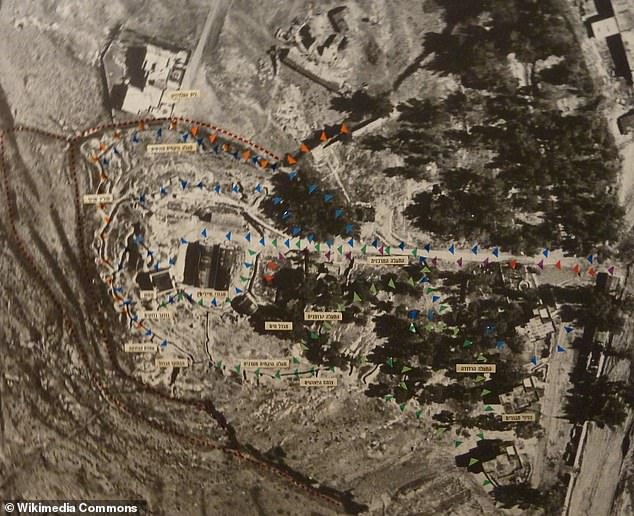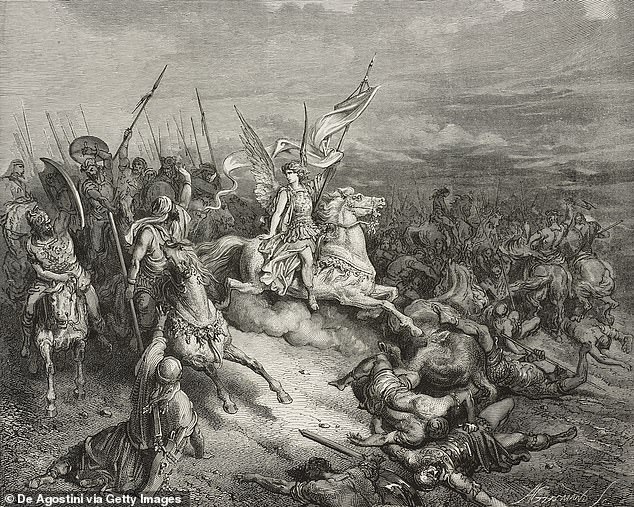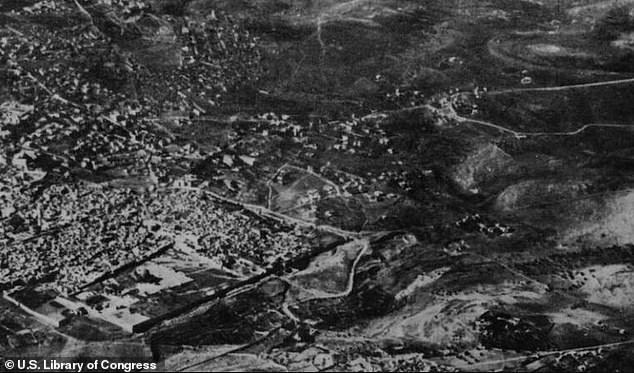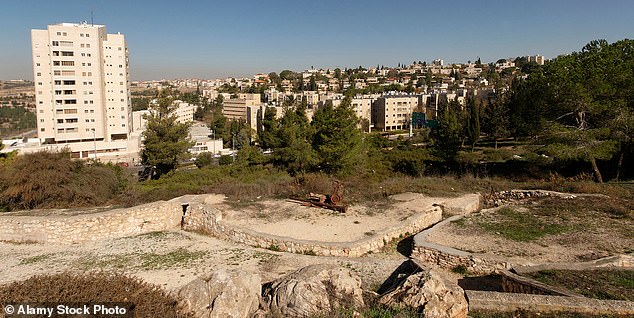Proof of Bible story about angels killing 185,000 soldiers in a night is uncovered after 2,700 years
Researchers have discovered an ancient military base that may confirm a Bible story about God’s angels repelling an attack on Jerusalem.
The story says that about 2,700 years ago, the Lord sent a messenger angel to fight an army of Assyrian soldiers who came to conquer the Holy Land.
Then the Angel of the Lord is said to have descended on the invading army and killed 185,000 soldiers in one night.
There is no archaeological evidence whatsoever that the supernatural event – or even the battle – actually took place.
Now, using modern mapping techniques, archaeologist Stephen Compton claims he has found more evidence that the epic battle took place.
King Sennacherib, who ruled from 705 to 681 B.C. ruled the Assyrian empire, besieged Jerusalem to conquer all paths leading to the Mediterranean. Pictured: (top) A 1930s aerial photo of Jerusalem (bottom) The drawings found on Sennacherib’s palace wall

The engravings showed how the military base was laid out, allowing Compton to compare it to photographs taken of the area in the 1910s (photo)
The Assyrian Empire operated from 1365 to 609 BC, hundreds of years before the time of Christ.
The invasion of Jerusalem was driven by the empire’s King Sennacherib, who wanted to assert his political and economic dominance over all routes through the Syrian desert leading to the Mediterranean Sea.
Researchers had previously discovered a scene carved into the stone walls of King Sennacherib’s palace, celebrating his conquest of Lachish, a city 42 miles south of Jerusalem.
The engravings showed how the military base was constructed, allowing Compton to compare them with photographs taken of the area in the 1910s.
He saw an area the same size and shape as the drawings on the palace wall, leading to ruins containing the remains of a perimeter wall and pottery shards.
After conducting an archaeological survey of the site, Compton determined that it had been abandoned after Sennacherib’s invasion and that no people had lived in the area for at least 2,600 years.
The find has paved the way for researchers to locate other similar military sites in the area and they hope it will lead to the uncovering of ancient cities destroyed by the Assyrian Empire.
In 2021, Compton wrote in a after on X, then Twitter, that he had discovered the location of Sennacherib’s military camps.
“Each was a circular site just over a mile north of the respective ancient city walls and each bore the same Arabic name on at least one early map, ‘Mudawwara,’” he wrote.
The location also meant that it was where Sennacherib’s forces planned their attack, as in Arabic it was called Khirbet al Mudawwara, meaning ‘the ruins of the invading ruler’s camp’.
Before Compton discovered the Assyrian site, researchers had come across only one other ancient military campsite in the area.
The secondary site was occupied during the Roman siege of Jerusalem and its layout gave researchers a way to compare the layout of the military camp to that of the Assyrians.
“Roman military camps were always rectangular, while this was oval, the characteristic shape of Assyrian camps,” Compton wrote in an press release.
The methods Compton used to find Sennacherib’s campsite led to the discovery of other Assyrian military camps.
“In some cases it was also possible to use the newly discovered camps to pinpoint the locations of ancient cities known to have been besieged by the Assyrians, but whose location was unknown or uncertain,” Compton wrote.

The angel of the Lord – written in Hebrew as malak Yahweh – translates to messenger of the Lord and was sent to protect Jerusalem after its ruler, Hezekiah, prayed to God for safety

Compton reported that the methods used to find Sennacherib’s campsite led to the discovery of other Assyrian military camps. Pictured: Aerial photo of Jerusalem from the 1930s

Three Bible stories in the book ‘Isaiah, 37:36-38’, ‘2 Kings, 19:35’ and ‘2 Chronicles, 32:21’ detail how the Assyrian soldiers were killed the night before they attacked Jerusalem. In the photo: the military site on Ammunition Hill
Three Bible stories in the book ‘Isaiah, 37:36-38’, ‘2 Kings, 19:35’ and ‘2 Chronicles, 32:21’ detail how the Assyrian soldiers were killed the night before they attacked Jerusalem.
In all the stories, the Israelite deity Yahweh sent an angel who passed through the camp while the soldiers slept and killed them all because they threatened his followers.
Bible passage 19:35 from the book ‘2 Kings’ says: ‘And it came to pass that night, that the angel of the Lord went out and smote in the camp of the Assyrians an hundred and five thousand; and behold, when they rose up early in the morning, they were all dead corpses.”
The angel of the Lord – written in Hebrew as malak Yahweh – translates to messenger of the Lord and was sent to protect Jerusalem after its ruler, Hezekiah, prayed to God for safety.
In another retelling of the attack, a plague claimed the life of the Assyrian soldier, while a Greek version claimed that the soldiers were left defenseless in battle after mice invaded their camp at night and bit through all their bowstrings and shield thongs.
After the Assyrian army was defeated, the hill lay undisturbed until the 1930s, when the British turned part of it into an ammunition depot due to its defensibility and renamed it Ammunition Hill.
In 1948, the Jordanian army captured the hill from the British and built defensive trenches around the perimeter.
The site changed hands again twenty years later as Israeli paratroopers fought to take possession of the hill during what became known as the Six-Day War.
Today the site is a memorial and museum dedicated to the bloody battle that left 15,000 Arabs and about 1,000 Israelis dead.
